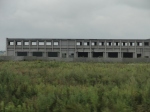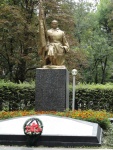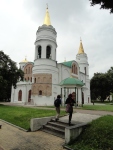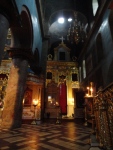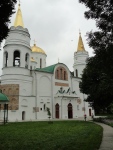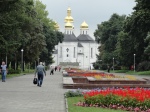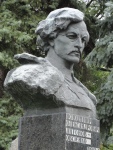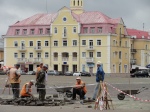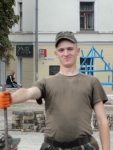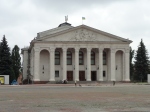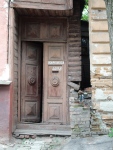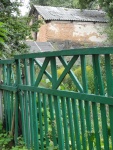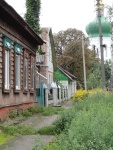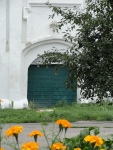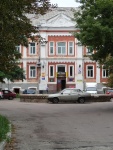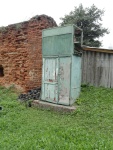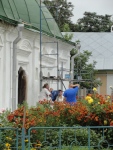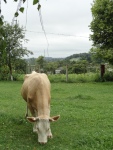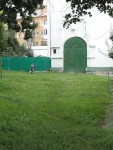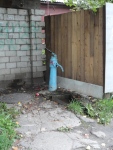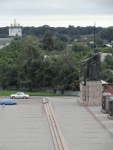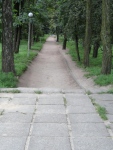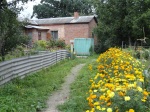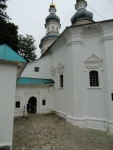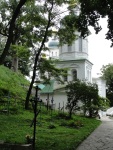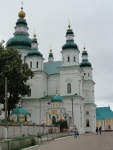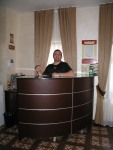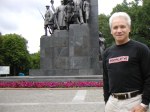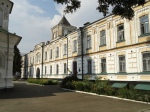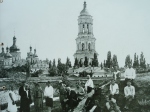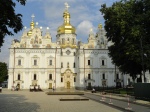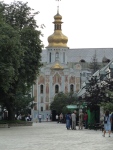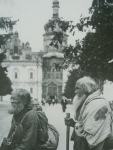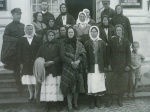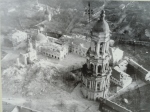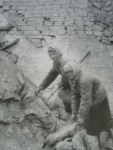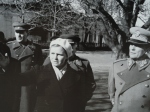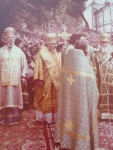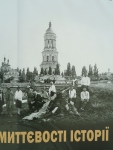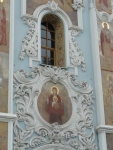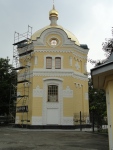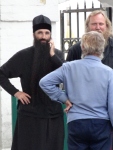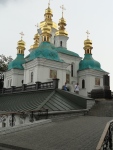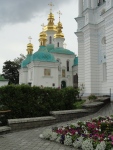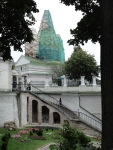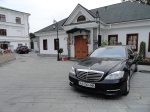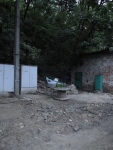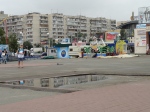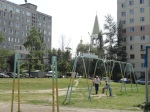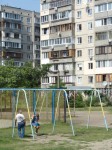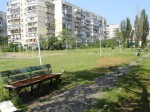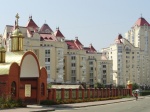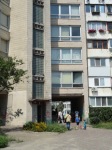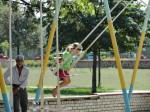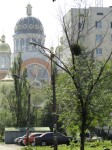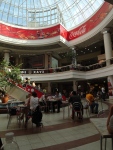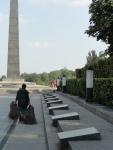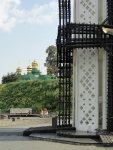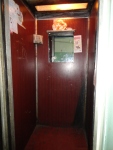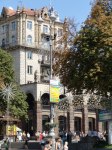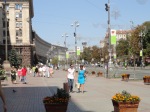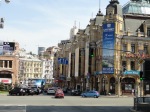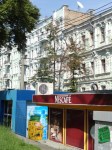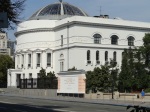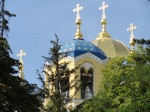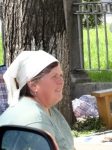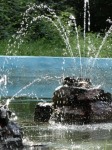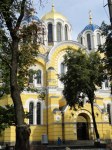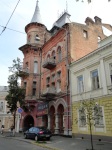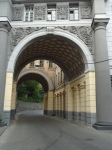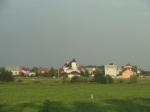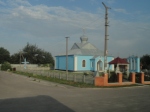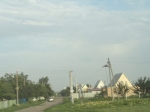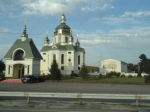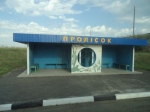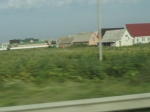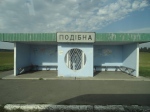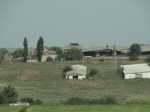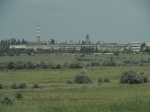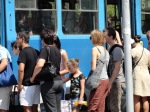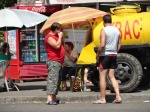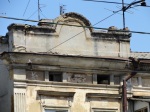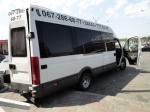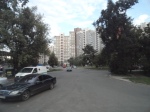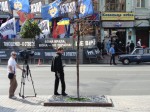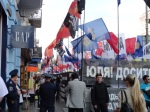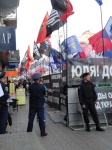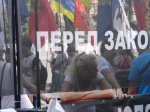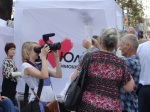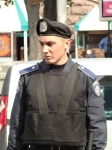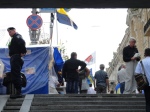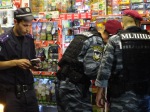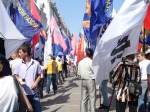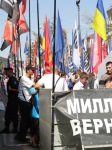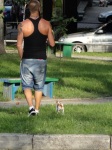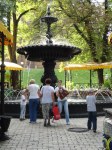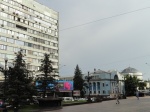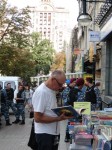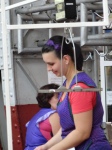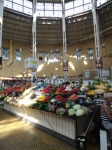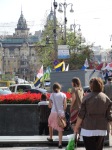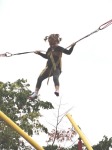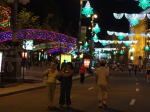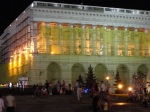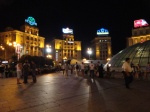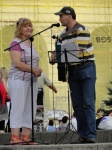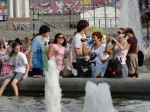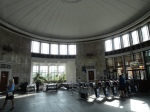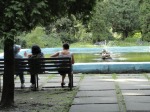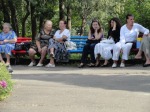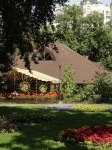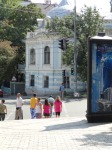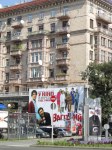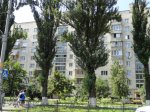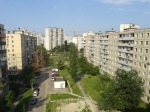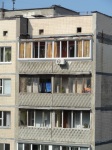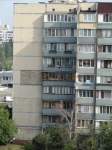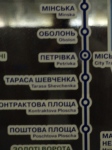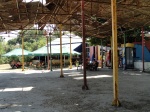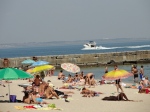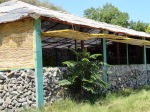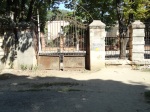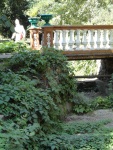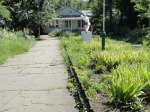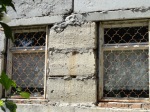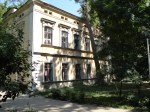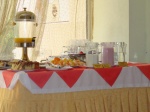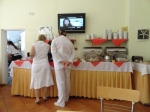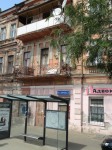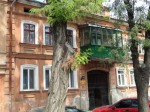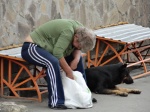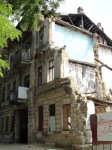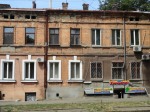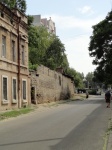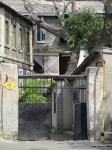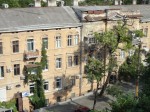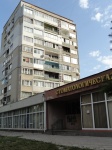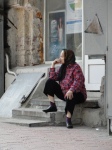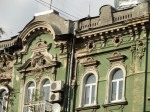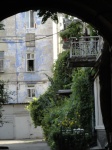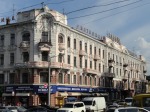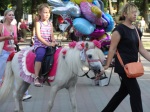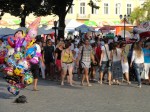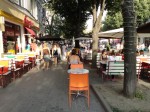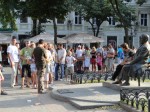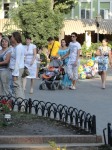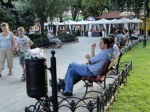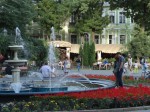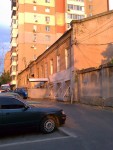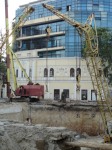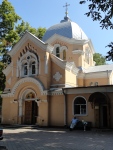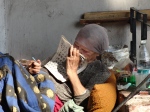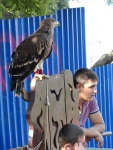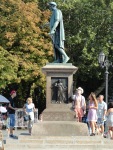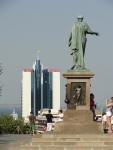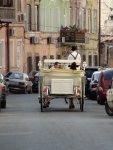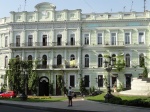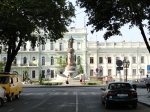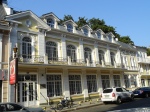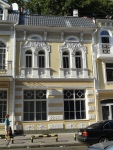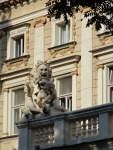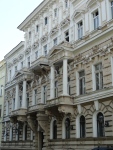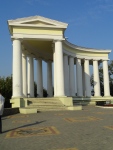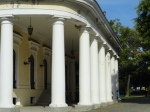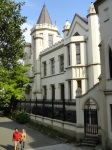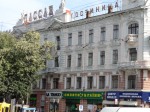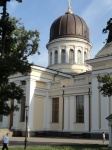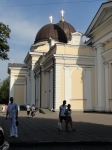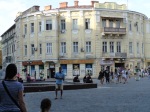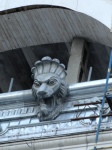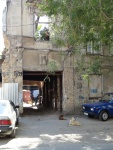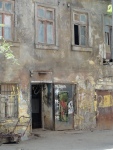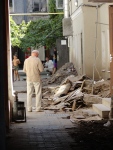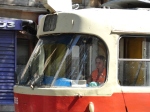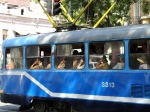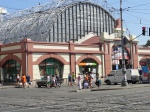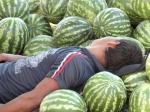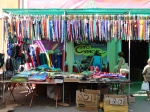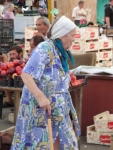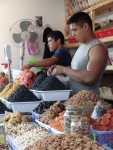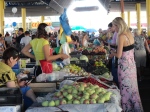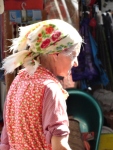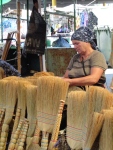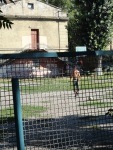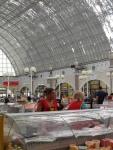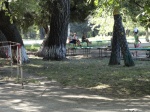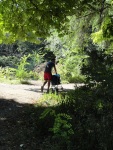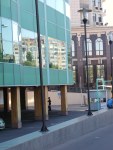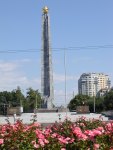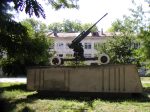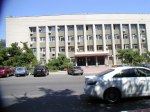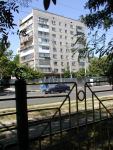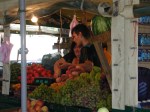The Russians want it back. Check this out to get a real flavor of what Ukraine is all about!
Ukraine
Architecture, City Planning, Politics and Economics
Chernhiv, the UNESCO Heritage Site
Chernhiv, Wonderful and Difficult
This will be my last entry for this travel blog. I’ve been back in the USA now for several days, giving me time to reflect on the Ukraine and on how to end this blog. When flying to the Ukraine, a German woman sitting next to me on the plane commented, “Hum, the Ukraine, now that’s not your usual vacation spot!” That comment didn’t hit me till later.
The Ukraine remains a series of complete contradictions and contrasts. I’ve used some of those descriptions in this blog. I think the most salient couplings include: wonderful and difficult; beautiful and ugly; warm and cold; happy and sad. Ukrainians maintain their integrity despite their sordid past. Overrun by almost every invasion of the past 1500 years, their culture survives mainly through their fervent nationalism, their pride and fundamental religion. One Ukrainian woman said to me “Orthodox is Ukraine, it is our culture”. Simply put and very clearly the case. Their religion permeates their society. Most people practice in some form or other.
I specifically chose the Ukraine due to the myriad of contradictions and mysteries surrounding this place, including the politics, the society, the architecture, the religion and the fully preserved Soviet vestiges political and physical. Where other places under the Soviet’s grasp have changed their surrounding, the Ukraine has not. It’s the best preserved example of the past I could have ever hoped for. I found a friendly, highly educated, resolute people that work for what amounts to $2/hour for 50 to 60 hour weeks, whether they are doctors or lawyers or psychologists, or teachers or truck drivers or architects. I found a country full of political activists in amongst the vestiges of the Soviet and Russian dictatorships. I found a people that watch our TV shows and movies (yes with horrible dubbing), that surf the same web and know the score. They want to improve their lot in whatever way they can, but have no clue how to start. How do you change a communistic system, which this surely is, into something more democratic and free? How do you boot strap your situation up to a level that’s reasonably close to Western standards? How does the 2nd largest European country manage to rejoin Europe? This is a country of Europeans, Slavs with the same heritage as Poland, the old Yugoslavia, Hungary, Czechoslovakia, Romania and even Sweden, with their political histories intertwined for over a millennium.
Each step forward equals two steps back. The Orange Revolution of 2005 has led to today’s political crack down, moving the country towards a Russian style dictatorship and away from the other Western European democracies. Salaries remain stuck at an egalitarian level representative of communism. I initially roughly scheduled my trip to coincide with the 20th Anniversary of the break-up of the Soviet Union, not knowing it was the exact date. I was unaware as most of us are of the arrest of Prime Minister Yulia Tymoshenko on trumped up charges and the dictatorial rise to power of the current President Viktor Yanukovych. NPR did a special today about the Soviet Union and satellite’s demise including specifics about Ukraine and Georgia. It’s worth a listen to give you a perspective. Soviet Union 20 years later and Russia, Ukraine and Georgia 20 years later .
I’ve seen the politician’s country estate villas and $300k cars, cars I never knew existed, Bentleys and Rolls parked in military rows outside Parliament guarded by Federal Police. I’ve witnessed the political crack downs in the streets of Kiev. I’ve seen the political elite in posh and exclusive lounges, penthouses and clubs. I’ve toured and lived in the Soviet Block Housing and Soviet planning. I’ve walked through the crumbling streets and parks and buildings throughout the country. I’ve ridden the dilapidated trams and Metro and Autobahn. I’ve seen the overgrown and bloated weeds both in the streets and political institutions. It is in many ways straight out of the 19th Century. Significant change will take a very long time. It’s a fascinating study. It is the exact reason to go and visit. It’s a rare glimpse into a bygone era that continues today. It is the purest look into the world of the Russian Empire and the Soviet Union. Wonderful and difficult, that’s exactly the Ukraine.
Chernihiv remains in my mind an allegorical example of today’s Ukraine. Check out Chernihiv Travel Guide and Chernihiv Photo Gallery . Of course I must maintain consistency and give you my personal favorite… http://en.wikipedia.org/wiki/Chernihiv as a gift to us Dummies. This very small town sits only a few miles from the Russian boarder and 20 miles directly east of Chernobyl. Its isolated location creates a living museum to the Russian and Ukrainian culture and religion. As mentioned, it’s a UNESCO World Heritage Site. It is the birth place of the Russian Orthodox religion. The churches remain the very first of the Russian Orthodox religion, dating from 1036 AD, making Chernihiv the birthplace of the religion. The traditions are deep and significant. Pilgrims from all over the Old Russian Empire flock to the town’s 3 main churches, cathedrals actually, photos of which are below. As I visited on a very stormy day, the light created glowing gold domes with muted landscapes accentuating the ethereal nature of the surroundings. I’m sure I was one of only a few Westerners that anyone had ever seen. You’ll note the stark differences between my images and the images of the Photo Galleries, an illustration of Ukrainian life, the wonderful and the difficult.
The Cathedral of Our Savior’s Transfiguration and the Holy Trinity and St. Elijah’s Monastery particularly struck me. Each illustrated an alternate world inside to outside. Outside the bright white walls and decorated domes acted as beacons throughout this pilgrimage town. Anywhere you looked whatever vista you took in, in the distance another gold domed church was drawing you to it. The inside remained dark and mysterious, with candles, dark frescos and the mummified remains of a number of saints encased in gold tombs. The saints, dressed in golden regalia lie in repose with their painted pictures on the wall above. All parts of the saint were covered by golden embroidered cloth and under a glass-topped golden sarcophagi. During the daily service precisely at 6 pm a handful of worshipers, maybe 2 dozen chanted in monotone led by the novice priests, then ascended the few stairs to kiss the glass cover, bow, genuflect and back away till everyone had done the same. It was repeated for each of the 3 saints in the nave and formed the basis of an hour-long service. The only light emanated from the plates full of spindly bees wax candles and narrow rays of orange sun streaking through the dust and soot, like beams cutting the thick air.
I explored this town thoroughly, finding it representative of many country side towns I’d seen throughout the Ukraine. With only a few paved streets, little in the way of electricity, no running water, only periodic plumbing, only a few toilets, no street lights, only a few public sidewalks attached to the grand Soviet scale plazas, otherwise a farming community within a town. In the attached photos you’ll see the public water pump, a typical public “toilet” consisting of a hole in the floor of an outhouse at a café where my guides and I dined, typical streets, backyards, shacks, hovels, all typical of this small town and many others. Yet the ancient religious icons remained the public focus, making all else secondary. Life flourishes within the inner world, not the external. The ethereal world overtakes the external trappings of life. The inner culture based in the Orthodox religion remains the basis for daily life in the Ukraine. Everything else Ukraine comes from this source.
It was from Chernihiv that I began my 48 hour journey home to Denver, by foot, then tram, then bus, then Metro, then foot, then taxi, then plane, a full 2 days from the most remote place I’ve ever seen…back to Colorado and Denver and life, normal life…for me at least.
I can’t resist one last story. While touring the backwater streets and churches of Chernihiv with my two guides, we wandered down the partially paved streets past the broken down houses fences and sidewalks. Both my guides spoke fluent Russian; they were friends I’d met in Kiev. At the end of the street a green domed church sat inside a fortified monastery wall. These are the photos with the yellow daisies and the green domed church beyond. We made our way around the fortified white walls to a huge open gate and walked in, much like walking through a medieval castle wall and gate. Once inside the grounds we entered another world. The bucolic compound exuded that distinctive monastic look of fruit trees, vegetable gardens, small well kept houses, monk’s dorms, neat formal walkways with flowers everywhere. Cows and chickens roamed all around with a beautiful vista of the hills beyond just over the walls.
I immediately started walking around shooting photos as my two guides started talking to the guy with the long white beard and long hair, obviously the head priest off duty on a Wednesday afternoon. The very fast Russian spewing from everyone got louder and louder by the minute. My guide’s arms were pointing here and there and everywhere as the priest’s arms were doing exactly the same. I’m shooting photos of the priest, the cows, the vista, the church, the nuns making their way around the yard, then the arms were gesturing at my legs. Again my legs! Yes, my shorts again…my bare legs were about to get us all thrown out of this quiet monastery tucked away in the darkest corner of the most rural Ukrainian/Russian landscape. The place where cows and chickens and birds and nuns and priests all coexist in harmony, my bare legs were now about to become the week’s news. Then the camera, gestures at my camera for good measure, course I’d already shot a dozen shots. My guides are gesturing, the priest and his helper are gesturing, everyone is pointing at my legs. I’m shooting photos as I’m back peddling up the driveway, the camera jammed in my face. I’m backing up in front of my guides not knowing exactly what’s up, but clear that we’re all getting shewed to the gate, followed by priests, apprentices, cows and chickens. We all escaped with the cloths on our backs and my shorts on my legs. Yes, I was thrown out of yet another monastery for my bare legs. I’m seeing a trend here. Next time I’m bringing my pants with the zipper legs that turn into shorts.
The Ukraine is not for everyone. It is not for those wanting Mexico’s sunny white sandy beaches, or the Rivera’s beautiful casinos, or Paris’ cafés or Copenhagen’s street life, or the relaxing spas of Sweden or fiords of Norway or pubs of Ireland. It is however a trip back into a living history, a culture in flux as it has been for many centuries, a society deeply rooted in its past, pride in its future and blocked by the realities of today.
If you want to go:
I found many fabulous friends across the country, in trains, in towns, in the apartments, in hotels, everywhere.
In particular, I met great new friends and benefactors in the places I stayed, in the apartment in Kiev, the boutique hotel in Kharkov and the seaside hotel in Odessa. I’ve included photos of each of them at the very end of the photos section, a fitting ending to a once in a lifetime trip into the living history book that is the Ukraine.
I suggest the following places for starters; each made my stay easier and more pleasant in every way.
Apartment Rentals across the Ukraine, a great alternative to hotels: In Kiev: http://tokievapartment.narod.ru
Hotel in Kharkov, small friendly, cheap boutique hotel: ts-hotel@ukr.net and Tsaritsynskiy Hotel Kharkov
Hotel in Odessa: Yunost Hotel Odessa
The Cave Monastery that is Kiev
Lavra a Magnificent Enclave
To see Kiev is to see Lavra. No visit to Kiev is complete without a tour of this ancient monastery and complex. This complex consists of dozens of churches and chapels, monastic caves and labyrinths, over a several hundred acre site on the bluffs above the Dnepr River. Lavra literally means underground tunneled monastery and this walled fort throughout much of its history, was one of the original seats of the Russian Orthodox faith, along with the famed St. Sophia and the monasteries of Chernihiv. To see more about Lavra go my personal favorite once again (remember for me, Lavra for Dummies): http://en.wikipedia.org/wiki/Kiev_Pechersk_Lavra and to http://www.kiev.info/culture/lavra.htm .
The Eastern or Russian Orthodox faith remains foreign to me and probably to most of you. The Russian Orthodox faith is the Ukrainian Culture. They are one and the same. Rituals and customs, probably dress and dance all radiate from this origin. Food, celebrations, holidays all relate to the Russian Orthodox church which most belong to. Attitudes, beliefs, morals, ethics, relationships are all defined by the faith in the Ukrainian culture.
The followers of the faith gather in large, gold encrusted, frankly opulent churches with dark mysterious interiors scorched by literally 10 centuries of candle soot and bees wax residue; more on the bees in a minute. In the small towns I’ve toured, the church sits on the hill or highest point overlooking often the squalid village below. The construction of almost all the church and monasteries exteriors includes bearing brick walls plastered and frescoed inside and out with niches or integral frames for the icons. The majority of the churches I’ve seen are constructed in a Romanesque style with the arches, windows, vaulting and domes all reminiscent of the Italian Romanesque initiated in places like San Apollinaire in Classe in the early 4th Century. Again my personal favorite: http://en.wikipedia.org/wiki/Basilica_of_Sant’Apollinare_in_Classe should give you the picture of the earliest fountainhead of this architectural style, of course more then half a century before the Russians used it. Like I said, better late than never. Course it was a stable and easy way to construct. I saw similar treatments as in Italy, such as the wavy floors and columns, walls, timbers, masonry, stone not crafted by any mechanization but crafted by hand. So these churches more than a half a millennium later, show unique developments of the Russian or Eastern Orthodox style including the characteristic onion skin domes and the square cross plan as opposed to the Roman cross of the Western Romanesque churches. Try this on for size. http://en.wikipedia.org/wiki/Eastern_Orthodox_church_architecture
In the churches, the women must wear babushkas to cover their heads and the men must wear long pants…you may remember my first experience in Kharkov. Pants…an important fact to know if you should want to visit any of these in the future, trousers are a must. There are no seats or pews of any kind, everyone stands and genuflects repeatedly while either viewing iconic images or when participating in the daily mass. During the mass, the priests dressed in elaborate robes and tall gold encrusted hats with long flowing beards and hair sing and chat in monotones as a small choir of priests replies. The head priests generally face a massive golden screen separating the square nave central domed space from the altar area as they recite monotone chants of scripture from memory and bow with their backs to the worshipers. With each and every new phrase and chant, the worshipers bow and genuflect three times, sometimes touching the floor with each motion. The sanctuary lit only with sunlight filtering through small round-topped windows in the nave’s dome, smells of burning candles and incense with the hundreds of scented candles set on large golden plates placed there by the worshipers. The fresco paintings blackened by centuries of such practices add to the sense of mystery. It’s silent and reverent and warm and glowing and scented. Otherworldly.
The grounds which cover several hundred acres right in the middle of the City include elaborate stone walkways, stairs, meditation gardens, long covered monastic bridge walks, large plazas and enclaves. Part of the tradition includes the sale of honey from the bees and their wax from all over the Ukraine. The practice and the enterprise not officially sanctioned by the church but supported by it. The monastic order at the Lavra remains one of the oldest and largest in all of the Russian Orthodox religion amounting to the Vatican of the Ukrainian Orthodox Church. Meditation rose and flower gardens spread throughout the entire complex with burial gardens featured at the upper church’s rose garden and elsewhere. You’ll also note the many brand new Mercedes available for the priests and monks, a universal feature of most monasteries I visited.
I had the opportunity to witness a service inside one of the main churches (in the last series of photos with the chapel and the priests outside). The inside of the church was dark except for the orange glow of hundreds of candles. The interior of the sanctuary was full of worshipers standing in neat rows, the woman on the left and the men on the right. Loud speakers broadcast the monotonistic chanting over the lower monastery grounds and gardens. In unison after each chant by the main priest behind the screen, everyone would bow and genuflect three times. The priest would come out from the screen, go through a series of chants, bow and then return back behind the screen. With each chant, some with a rapid fire staccato delivery, the entire congregation would genuflect 3 times touching the floor each time.
The hour long service ended with the small choral chants of the novice priests as the congregation walked and bowed slowly moving outside to the open terraces. Everyone backed out of the church, no one turned their backs, everyone was silent. They tolerated my presence though some eyeballed me warily as I stood at attention with my hands folded in front of me. I left the church, the sun setting, the orange glow of the candles following me through the massive arched doorway onto the outside stone terrace carved into the steep hillside covered in roses. I made my way through the monastery, up the cobblestone walks, past the walled fortress, the meditation gardens and covered walks, the fragrant flower gardens, the main cathedral, and on to the gates to the street, feeling a bit transported to another place.
I’ve includes some historic photos that were on display at the monastery. Incredible photos dating back into the earliest shots of the place, the mid 1800’s. They show a photo history of the difficult past not only of the monastery but also Kiev and the Ukraine. Many shots depict the Nazi invasion, destruction and subjugation, the various wars and the hay day of the Soviet Red Army. They tell a history deep, rich and difficult.
On my way out, after a day of exploring and walking, exhausted, I simply had to get back into the center of Kiev by train. I couldn’t walk any more; I’d done my dozen miles already. It was a very hot and humid day. I always forget that the GPS and mapping do not register vertically, just horizontally. Somehow all the mapping and GPS works great on my smart phone even without network coverage, saving my ass from wandering aimlessly around through the maze of streets and buildings. Anyway, I appear only as a blue blinking arrow on my GPS map and I’m only a short way from a Metro station right on the Dnepr River far below. Take a quick look at the last several photos at the end of this photo album. I’m headin’ to the river far below, remember the large uninterrupted riparian woods? So, I start making my way towards the Metro stop, my GPS is showing I’m right on top of the station. I’m moving down the steps in the photos then along this very fast moving cobble stone road with cars rrrrrrrrrrrrrrrrrumbling up and down. No station…I’m walking back and forth, back and forth, now it’s getting very dark.
I’m getting nervous and gazing down the steep slope into the thick dark woods, down the equivalent of a ski slope through the woods. I say out loud, “SCREW IT!” I look left and I look right, I jump the railing and slip slide down through the woods, down, down, down holding onto trees and stumps as I slip and slide down trying to stay off my ass. It’s just like sliding down the Enchanted Forest at Copper Mountain or Upper Hullio at Killington in Vermont in the summer EXCEPT for the bottles, cans, hub caps, busted furniture, refrigerators, mattresses and junk. Now I’m in for a penny, in for a pound, I’m way too far down the hill to return back up. I finally reached the bottom but there’s a tall fence with no end and I’m INSIDE looking out. Well, I’m writing this so you know I finally found a hole, literally and slipped through to freedom without getting shot for being in somebody’s secure yard. I scrambled to the street, then to the Metro whose station was indeed set deep into the hillside underground, successfully transferring to some indecipherable Stansia Khrushchev-esky Ploscha sounding station. I finally made it back to my Kiev home to my now very safe feeling apartment, exhausted and with mud all over my white sneakers, temporarily hiding the tell-tale sign of my Americanism…white sneakers!
The Heartbeat of the Ukraine
Kiev’s Pulse
The City of Kiev offers surprises at every corner. It is certainly the most beautiful city I’ve seen in the Ukraine as well as the oldest for that matter. The international flavor permeates the streets and the feel of the place. It sits in and around the Dnepr River, which splits into dozens of delta like islands as it passes through the middle of the City. The oldest part of Kiev, the Lavra monastery dates from the 11th Century, but as mentioned before, the City was founded around the time of Charlemagne. http://wikitravel.org/en/Kiev The oldest part of the City center rests high on the bluffs to the West of the Dnepr River and islands. This offers a unique opportunity for a massive natural riparian area in and around the river, amounting to a huge green and wild area park right in the middle of the City! You’ll clearly see this in the photos with the high rises of the City in the distance. On these islands are dozens of sandy beaches for the hot summer days, though again, the water quality remains an issue let’s just say? Remember, Chernobyl sits on the exact same river about 70 miles up-stream to the north. Before and during its infamy, it sported a unique Soviet style open water cooling system which operated just fine up to and through the disaster if you get my drift. They didn’t even tell the folks in Kiev of the disaster till almost a week after it exploded so environmental issues still remain, I’m sure.
The City is alive in every way. The mixed use, pedestrian friendly shopping districts interlace within and throughout the entire downtown. There’s never a dull moment. From the market to the shops to the kiosks and coffee shops, the street and metro train performers, there’s always something to do or watch. A surprising number of parks run like ribbons in every direction. The Botanic Gardens while still a vestige of the grand parks of the Soviet days remains a wild and green zone within the center of the City attracting folks of all ages as you can see below. In many areas you almost can walk uninterrupted through the City’s center in a park or grand pedestrian walk or along the entire length of the Dnepr.
My buddy Joe Simmons and I have been bantering jokingly about Corbu and his craziness of making only grand and grandiose plans and imposing them over the city fabric in a New York second. The Soviets with the unfortunate opportunity created by WWII, did just that. Some of the photos below and previously show the “beaming in” of a huge faceless high-rise housing project within a Baroque or Renaissance or mixed-use urban fabric. I’ve included more images of this housing not that there’s a particular location but to illustrate it’s absolutely EVERYWHERE! It’s in the City center, for example, right across from the front door of the Grand Opera building, it’s in the inner zone, the inner, intermediate and outer rings of the City. The old stays old and run down and as you see utilizing a ubiquitous worn out urban fabric, devastated landscapes, public areas and open spaces. I’ve seen this on every one of these projects, exactly the same as the photos show. It’s ubiquitous throughout the City as well as throughout the three major cities I’ve visited. One issue may be that when independence was won from the Soviets in 1991, if you lived in an apartment it was gifted to you. They forgot however to include an HOA so there are no collective responsibilities or solutions.
They continue building brand new housing projects of the exact same scale and dramatic flare that matches the old in every way except for that it’s brand new. The style may be a permanent fixture as the infrastructure serves the city center well, there remains ample and considerable vacant, abandoned or under utilized land. Besides where would you put 4.5 million people if not in high rises without spreading out like LA. HA, there’s a good one! Sprawl is by definition not sustainable. Densification may be one way forward, but it must be done sustainably, slowly, measured. The best solution may lie in simply looking at the successes of the inner city and applying those same concepts slowly over time to the new. This remains one of the downfalls of Soviet style planning, a la Corbu…amounting to the “Big Bang Theory”. To make a place, make it big and make it fast. Slow development over time is negated. Cities must evolve slowly morphing, adjusting, growing over time to produce a success in terms of what I’ve called the Triple Bottom Line cubed, P33 suggesting People, Prosperity and the Planet, all interlinked together into a matrix that supports a broad and successful plan.
Kiev remains a great example of creating healthy, sustainable urban development in a thriving metropolis by building for the future by looking to the past. Those successes all over the City inform how to move forward into the future. Kiev is growing and growing fast. The persistent back water flavor of the Ukraine is almost erased here in this City, though the Soviet legacy remains stagnantly entrenched more here than almost anywhere on earth. While the political center of the Soviet Union, Russia continues to invest heavily and prosper from a number of industries including the extraction industries, there remains little money to invest and rebuild in the Ukraine. Using the “making lemonade out of lemons” allegory this gives Kiev, Kharkov, Odessa and all other urban areas of the Ukraine the opportunity to learn from their past lessons. This may be the clearest definition of sustainable urban development I can offer. Build for the future by looking to the past successes and failures.
Clear and simple, eh? Not really, I always tell my students, sustainable architecture is easy…all’s you have to do is choose it, but sustainable urban design…now that’s a different story! Some of the best, the brightest and most famous architects have fallen flat on their faces and created the worst pariahs of city development, leaving us their busted theories in the built environment. Le Corbusier who I’ve beaten on quite enough and FL Wright with his universal suburban model of Broad Acre, both authored dismal urban design failures. Sustainable urban development…now that’s rocket science!
I’ve included not only images of these successes and failures, but also of the central City’s St. Vladimir Orthodox Church as one of many examples of successful and sustainable city design. First of all the place has been there for many centuries. This is a religious icon for the Russian Orthodox faith and serves a wide number of their followers within downtown Kiev. The church is alive and active, it’s an attraction, people flock there to see and watch and worship and just sit.
City planning wise I use the very technical phrase…“putting butts in the seats”, enlivening a place and creating an overlapping synergy that feeds on itself. Essential qualities for successful and sustainable city design.
Now I suspect you know that I’ve saved the very best for last! My last several installments will WOW you with Russian Orthodox monasteries and churches galore, what Ukraine is famous for! The two most famous Russian Orthodox centers in the country include: Lavra along the bluffs above the Dnepr in central Kiev and the very rare treat of the monasteries and churches of Chernihiv. This religious center and town lie right on the Russian border, less than 10 miles from Chernobyl and remain one of the newly designated UN World Heritage Sites and a rare list worldwide. UNESCO_World_Heritage_Sites_in_Ukraine .
Both religious centers along with St. Sophia shown earlier in this blog cradled the formation of the Russian Orthodox religion just after the end of the 1st millennium through a tenuous alliance with the Holy Roman Empire seated just to the South in Constantinople. The first Orthodox Church in all of Eastern Europe, the Savior-Transfiguration Cathedral was built in Chernihiv starting in the first decade of the 11th Century.
It is Normal…
It is Normal…
You hear this everywhere. It covers quite a bit of territory…its OK, its good, its safe, its fun, its sweet, its easy, its usual…to name a few. So everything is normal. Which of course, this entire trip…is decidedly NOT! It’s been a real eye opener that’s for sure.
There’s really nothing I won’t do for this Blog I’ve decided. Nothing! I’m getting over 500 readers a day so now that I’ve got your attention, I’ll go to great lengths to keep you coming back. Here’s the deal. I gave up a perfectly good 1st Class train ride from Odessa to Kiev for the sake of “seeing the country side”. Well, I got to see it all right, in the heat of the day. So now I’ve traveled just like a real Ukrainian. Let me refresh your memory about the 1st Class train? So from Odessa to Kiev, 500 km, the 1st Class ticket cost $21. The bus, not 1st, 2nd or even 3rd Class, cost $23…crazy money in either case, but still an example of private enterprise at work. The difference? The train travels overnight in the pitch black, the bus during the bright sun of the day. So bus it is.
The trains which are run by the government remain left-overs from the Soviet days, with all the trimmin’s. For all the, let’s just call it character, the trains feature linens, and sheets and lace curtains and oriental rugs and flowers on the tables of the glass enclosed semi private rooms. There is air conditioning and coffee served in silver handled glass cups with sugar and milk. There is beer to buy and there are bathrooms of all things. Yes, bathrooms! Imagine! There is stereo music. There are plugs to charge your computer and phone. There are stops along the way and little shops that sell sandwiches and carbonated water and candy bars. BUT…the trains only leave at night, after 11 pm and arrive at 8 am. I would have missed the countryside and scenery and would have nothing to tell you except for how great my dreams were overnight. Ho hum.
The bus started out with a real bang. All the while I’m thinking, this is a HUGE mistake, I just know it, I can feel it in my gut, HUGE! But…anything for the Blog, anything! I get off the tram from the hotel with my 50 pound luggage, I’ve purchased the bus ticket the day before, I know at least that much. I go to the station…no bus. I go to the ticket office, no one speaks English. I finally find the bus with the help of a ticket lady. It’s not in the station, but across the street in some side gravel parking lot, like it’s a black opps bus or something flying under the radar. Sketchy. So I meet “Bus Boss” at the bus, strutting around and yelling in Russian with a huge fist full of cash. You can see him in the photos below; he looks like one of Tony Soprano’s henchmen with his posse. He’s strutting up and down along the bus, directing people, pointing, calling drivers over, wildly motioning, shewing unwanted passengers away, conferring, scowling, screaming, whispering, waving his arms, talking to himself, a deep furrowed scowl imprinted on his face. He’s constantly counting and recounting his fist full of money. All he sees is some English-speaking American in white tennis shoes and a 50 pound bag and that’s all he needs.
I consider myself case hardened when it comes to tough guys as I put myself through most of college as an owner operator hauling steel on an 18 wheeler, yes a steel hauler, I was a teamster. I hauled steel from the steel mills of Pittsburgh, Detroit and Chicago to the car plants of the mid west and the piers of Cleveland, Buffalo and my personal favorites, Brooklyn and Newark. You can imagine the characters you meet in such places blatantly run by the mafia, grubbing fists full of cash, screaming, directing, yelling. Nothing happens unless cash moves. Bus Boss was cast from just such a mould.
When I paid for my ticket I had a ticket receipt but the ticket lady snagged it despite my protests when we finally found the bus. So I have no ticket, Bus Boss who was already introduced to me, screams at me “Pay” waving his fist full of cash in my face. Pay! “I already did” I retort. Pay! “I had a ticket!” Pay! So off I march to the ticket counter worried they would leave without me and with my luggage. I find an English speaking customer, after a dozen requests and some animated pantomime I get a receipt. I get back on the bus, which is rapidly filling up. Bus Boss, scoffs at the receipt until the ticket lady who is obviously the real Bus Boss says something nasty and he backs off. He totally ignores me till we leave, scowling the whole time. No cash moved. See, rules get broken.
Now this is no Greyhound bus like I’d assumed it was. It’s like one of the RV Econoline vans you see lumbering along the Colorado mountain roads this time of the year. It seats maybe 25, but in very small cramped seats. I’m a small guy and I can barely fit into the seat, my knees are rammed against the seat in front and the back of the seat is 6 inches from my nose. This is going to be a great 8 hour daytime journey. But anything for the Blog!
It’s of course the middle of the summer, the temperature and the humidity both hovering in the mid 90’s. The sun has baked the bus for hours now. The temperature in this sardine can easily surpassed 100. I’m sitting with my knees and nose in the back of the seat in front, sweating like I’m in a sauna. Off we go. I’m just counting the minutes for the thing to get moving so the AC can kick in. Never happens. I’m looking at a dashboard full of knobs with AC written all over the place, no AC. No operable windows…the thing is hermetically sealed. The driver you’ll see in the photos is Ukrainian so the rule is 2 wheels on the road at any one time. The driver pops in a DVD movie, something like the Russian version of a combination of the 3 Stooges and Barat with that overly colorful color and the sound blaring to distortion. I’ve been drinking water to stay hydrated, but 2, 3, 4 hours into the trip, no stops. You get the picture. It is normal!
We’re flying along this seeming interstate style highway. It looks like an interstate, but dirt ramps and no shoulders and no clear edge to the pavement and grass infiltrating the road and no pull off apron and no fences to keep out livestock and no median and no lights of any kind indicate otherwise. For the first half of the trip, maybe 250 km the 4 lane highway was bridged by overpasses, but none were finished. The concrete supports and in most cases the concrete beams were mostly in place but no ramp to the bridge in space, no decking, no road, nothing but the bridge structure. Everything looked as if it was like that for decades. Like they had a huge building boom and then the money vanished. They never finished it. It is normal! So the highway cut the countryside in two like a river, with no way across but to access the dirt entrance ramps and race across oncoming traffic. This was possible as the highway had no median, or guard rail or strip in the middle. It was one huge tarmac of concrete for all 4 lanes of traffic with a flat paved center. I’ve seen this in the old East Germany, where the highways doubled as military air fields, allowing large transport planes to land if necessary, all vestiges of Soviet days. The road eventually deteriorated into a complete patchwork of potholes, half completed repairs, tar, gravel and asphalt. We rumble over these unencumbered.
As we fly along these sketchy roads, the collective farms and abandoned factories wiz by. The huge Soviet collective farms created massive unbroken tracks of land as far as the eye can see. It looks much like the Eastern part of the US, places like upstate NY State or Ohio, with bands of green trees, huge open slowly rolling fields, but in this case a complete lack of any farms, barns, houses, garages, sheds, silos, roads, electric lines, or structures of any kind. Huge high tension towers dot the landscape to the horizon without any electric lines and broken truss struts hanging from the huge towers like scarecrows with broken arms. It’s beautiful in a way, but very eerie in another. The fields are tended to and planted, but nothing and no one is around. It’s empty except for the planted crops. It’s very empty and very strange. You’ll see this in the photos below.
There are no cross roads or exit stores, or shops, or gas stations, or buildings of any kind. There are no restaurants or fast food or inns or motels or hotels or Starbucks or literally anything along any of the route. There are no rest areas or bathrooms or rest stops or pull offs. Trucks pull off at the exits and line up right next to the road. Locals sell produce and wares on blankets spread along the side of the road at mostly dirt or barely paved off/on ramps and pull offs. The locals sit watching the traffic speed by, with only a few trucks and cars occasionally stopping. Bus stops along the road are either concrete bunkers and outhouses or just a spot along the way where you stop and got on or off the bus. You pay the driver in fists of cash, who knows where it goes.
The small towns and villages came into existence to serve the now defunct collective farms or factories. Now everything is decaying into the earth with huge metal grain elevators and sheds like you’d see in Iowa, or abandoned dilapidated factory shells in the distance. Often a series of silent smoke stacks or factories with broken glass, weeds and trees over growing everything appear in the distance. All roads in the villages were either dirt or tar and gravel, but done decades ago, everything now overgrown. There were no stores, shops, or much other than houses arranged in tight rows, often constructed of whatever was available. The only stops of any kind were gas stations directly on the highway, in modern and shiny new buildings, like thruway rest stops. There you would get the monopoly priced gas and pre-made food, packaged and sold as you filed through the long lines.
As we hit the outskirts of Kiev, you could see some distant village farm houses and single family developments in sparse clusters along the green hillsides. Those immediately gave way to more high-rise apartments, and then to shops, offices, stores, schools, boulevards, tree-lined streets and human activity, hitting the hard edge of the city with little in the way of a suburban style buffer. You are in the country and then you are in the city. That’s normal. I arrived in the early evening to the Kiev Central Bus station which amounted to a dirt parking lot, our lone mini bus and small kiosk shops strewn about. Not a taxi in sight, the skyline of Kiev in the distance, unfamiliar surroundings and buildings, bridges, overpasses, highways. As darkness settled in, it was me and my 50 pound bag standing along the side of the road, with anonymous trolleys, busses, trolley busses, Metro trains and cars whizzing by. Welcome back to Kiev, by bus.
Life is normal back here in Kiev. I’ve included some more shots of the typical and universal housing that rings the entire city, similar to Odessa. Everyone here too lives in these apartments throughout this city of 4.5 million people.
I’ve included some shots of the protests in Kiev. The X Prime Minister, Yulia Tymoshenko remains in prison on charges of embezzlement, discussed in an earlier entry. The protests against the Russian leaning authoritarian President’s regime, previously violent now resemble political rallies. Flag waving, singing and peaceful demonstrations have replaced violence. Each day you can hear the speeches and uplifting music through loud speakers throughout the downtown. Some speeches sound angry, some uplifting, some preachy, some lively, all intermixed with dramatic political music and flag waving. The police presence however remains dramatic and heavy-handed as you’ll see by some of the photos. I’ve seen many hundred Federal Police lined up on the side streets with their buses stretching for blocks from the Main Street where the protests are staged. Yes, political unrest appears as a normal part of Ukrainian life and will continue for the foreseeable future.
I’ve also included some shots from around Kiev from my first day back to this thriving Capital. It truly is a wonderful and lively place, with all the things that make a city great. The faces and the places make this an international city, unique among all others.
Odessa: A Day in the Life of…
Odessa from the local’s point of view
This historic vacation spot by the sea remains one of the Russian and Ukrainian destination spots, despite the issues with the economy and the expense. The place is teaming with tourists, locals, Ukrainians, students, Muscovites by the hundreds and even thousands! I saw entire gangs of brand spankin’ new motorcycles parked at various beach spots, the hottest bikes, all with the Mos Rus stamp on their tags. The Muscovites I spoke to were fluent with exacting English, every single one of them! They all emphatically dispelled the warnings I’d had that Moscow is expensive, unfriendly and dangerous, a rumor I’ve heard repeatedly. I found them highly educated, extremely friendly, exuberant, articulate, jovial and speaking like they were from the States, or shall we say…with the State’s English, Moscow is not on the itinerary this round, but that and St. Petersburg will be on my next trip’s must see list for sure!
The Soviets flocked here, well at least the Party elite did for decades and as a result the place is full of high-rise 1950’s and 1960’s style hotels and post war resorts. Yes, Corbuized again…take that Mr. Fancy Pants Smith (my x biz partner with the Corbu quip in the comments section). Make no little tiny structures or plans. I stayed in one Corbu style Soviet structure called the Hotel Yunost, photos below. I’d relayed some of the comedy of the place already, elevators and toilets and such…but found the staff wonderfully friendly, English-speaking and always helpful, remembering that almost no one outside the hotel/travel business speaks English. I made two great new friends, the two Concierges, Helen and Anton. They saved my ass more than once and helped me do everything from find a new camera…remember that story…to get on the right bus to not end up in Siberia. It’s actually quite a scary prospect being transported immediately from a literate and functioning individual into a blithering illiterate idiot who can’t read or write or speak anything. It’s a real sobering experience. It gives me a true appreciation of how difficult it is to be a non-English speaking alien in the USA…and I get to be re-transformed in a week! Phew!
As you’ll see in the photos, I ventured to a number of Black Sea beaches, the reason for most of the visitors to this resort town. Well, let me just say it’s more like swimming at Jones Beach in NYC than the white sands of the southern Jersey shore or Virginia Beach for that matter. You’ll also see that the port is a fully HARD working port so all the offshoots of that end up on the beaches. Those photos are coming with the next installment. The beach ambiance is truly more a matter of taste, with old busted up concrete landings, platforms and abandoned buildings everywhere. Oddly the beaches are all cut into separate chunks of about 100 – 300 yards each separated by very old and crumbling jetties that jut into the water, forming piers. You might think it’s to break up the surf, but I believe a more likely explanation is the many “private” beaches and resorts left from the Soviet days that own everything right up to and into the water, unlike our beaches. It was not at all unusual to be walking along on a sketchy path in the weeds above the beach and then encounter a 20 foot tall, solid, continuous wall extending up the bluffs with absolutely no way around either above or into the water below. Must have been the Soviet elite again making their own resorts, I’ll of course never know. I’m not an elite by any stretch and am reminded of that fact daily by most my friends.
Life is a matter of what any of us gets used to. Anyone can move along day-to-day in any circumstance and get through to the next day. Human nature is malleable and we get used to our lifestyle. The housing by our standards in many cases looks run down and poor and scary. This is actually not at all the case. While the exteriors are often dilapidated, the interiors and living are quite nice. Maybe more like Venice, where all the buildings look like they were worked on 2 centuries ago. Well maybe not, but remember, it’s the x Soviet Union where quantity and not quality was the rule. The interiors are organized along one hallway, all the rooms have doors including the kitchen, living room, bedrooms which radiate directly off this interior and dark central hall way. All the living spaces are directly exposed to the outside of the building for light and air. The apartments I was in were small yet very nicely done with nice woodwork, tile and lace on the windows.
The housing is not dissimilar from our own in the US as a concept. Of course almost no one has their own suburban home, but really only some of us have those Broad Acre replica’s with most of the folks I know in Denver living in the City itself. There’s just more multi family high density housing and it’s bigger, much bigger and older and more like the Grand Soviet style. Invariably, there are a series of concentric rings around the cities; the inner rings include historic 2, 3 and 4 story walk-ups some with shops on the first floor. Yes, yes, exactly like we’ve magically just reinvented as the latest and greatest urban mixed-use model. Wow, are we cleaver or what?! You’ll see this in some of the photos below with many grand Baroque apartments originally built as apartments 200 years ago, largely remaining in tact with similar shops on the first floor. Most of these in the cities that I’ve seen are in complete disrepair and in many cases the Baroque details either falling off or completely gone over with a Band-Aid.
Oh yes, those huge Baroque mansions in the photos below originally belonged to wealthy aristocrats of the Russian Empire. Those were set in the grand Baroque style amongst the now overgrown formal Baroque gardens complete with empty pools and broken statues. They eventually all became communist housing during Soviet times. Today, these now disheveled mansions serve as public housing for a Sanatorium, though I’m not at all exactly clear on what that is.
Throughout the city, old crumbling Baroque housing sits directly next to a completely renovated structure or ultra modern building. Many of the photos below with the seemingly disparate images of ultra modern vs. blown out wrecks are directly across the street from one another. It’s like a museum. There are some examples of in situ historic structures completely in tact…untouched originals, there are crumbling original structures with their guts hanging out, there are poor renditions of functional renovation and there are beautifully restored to the last detail. It makes quite a stark mix, shocking really. Many of the original Baroque structures still have the original wooden lattice-work that originally received the gussied up fancy ass, dripping Baroque detailing in plaster rather than stone, typical of this late Baroque Era.
Walk-ability, pedestrian friendly (except the cars), transit oriented mixed use, TOD’s, shops, sidewalks, parks, tree-lined streets, remain the general flavor of the inner city ring of housing, within the old city limits. As soon as you step outside the inner historic city, it’s a completely different story.
Then you’ve once again entered the Soviet style high-rise housing, with an odd intermixing of shacks and hovels in between. When you look at the photos below, I know many of you will suggest that I’m as crazy as you’ve suspected. Yes, there were a few spots that I felt a little queasy with that ticklish feeling under my feet and hair standing on the back of my neck as I strolled along like I belonged there. But most of the time, there were men, woman, kids, families strolling around too, so it felt much safer than it might appear.
I got deep into some of these developments if you want to call them that. Many are eclectic hovels and huts assembled during the Soviet years out of necessity and whatever materials they could scrounge up. These hovels included some very nice cars parked in the “street” if you can call it that. Wild dogs roamed the streets in packs and most were benign but in two cases I had to negotiate my way out with the best Dog Whisperer imitation I could muster. Only once did I grab for a stick to fend several off, counting my blessings not having to use it. The place for the most part was at least clean though run down as you can see. There are no lawns, or trees other than volunteers, no gardens, no awnings, or picnic tables, or walks or playgrounds or entry plazas or any other amenities you might expect in a housing development. There were the basics that’s it. For the most part almost none of it was dangerous despite the look, no trash, neatly kept, though in need of a complete overhaul.
Remember, these are not the “projects” like the ones we tore down or blew up in the last 2 decades. This is not Pruitt Igo, or Cabrini Green or Bedford Stuyvesant, or the Bronx or Jersey City. These are not low-income housing projects. The average Joe and Jane live here with their families. They are teachers, and doctors, and lawyers, and firemen, and police, and shop keepers, and bus drivers, and engineers, and archie-tects that live in these apartments and are lucky to be doing so given their salaries.
Ok, one quick antic dote for comic relief…I’m doing my usual archie walk along the streets of these high-rises, my head facing skyward towards the buildings, my eye jammed into my camera, not watching where the hell I’m going. Those of you married to an architect know exactly what I’m talking about, you can’t take us anywhere. Anyway, I’m walking and shooting and focusing when WHAM, I slam my chin full throttle right into this steel pipe which just happens to be planted knee high right in the middle of the sidewalk! In the middle! It drew blood and some choice American slang that thankfully none of the Russian speaking population could understand.
Public Life
The great part of life for the Ukrainians exists in the streets, in public. The public parks and spaces are plentiful and everywhere. Both men and women dress up just to step out the door. They wear fancy and colorful cloths, the women often wear beautiful high heels everywhere even walking over unimaginable rubble and crumbled walkways. The men wear pointy, bright white leather shoes and white slacks and collared colorful shirts when out in public. You’ll never see a local out in a tee-shirt and seldom shorts even though the temperature and humidity are both hovering in the 90’s. The dirt and destruction under their feet is negated by the beauty and color of their dress, almost in defiance of the realities of life. Their homes are small and modest, they must live together in extended families to afford a place, they cram by the dozens into trams and trains and trolleys and buses, their salaries are meager for working long hard hours often over time and on weekends. Yet they seemingly compensate by going out in the evening to the numerous parks, and public spaces, and churches, and plazas, and fountains, and gazebos, and sidewalk cafes, and pedestrian malls by the thousands, dressed to the 9’s. This promenade is really something to see, as you’ll see in the photos.
Oh, by the way, one more thing. All these photos are taken within the central part of Odessa, no long trips out to the hinterland. No excursions, just a regular trolley with the locals, off at the stop or station and a short walk in many cases with the locals returning from work or promenading in the evening.
Odessa’s Public Beauty
Odessa’s Baroque and Grand Public Spaces
This remains one of the most intact and spectacular Baroque cities I’ve seen since Italy. The difference is that this was done all at once and by one builder as discussed earlier. This grand building boom from the late 18th to the early 19th Centuries remains unsurpassed in the Russian Empire. Remember that Russia ran the place since the mid 17th Century uninterrupted except for about 10 minutes between the fall of the Czar and the rise of the Bolsheviks. Russian through and through,Odessa remains one of the purist examples of Russian Baroque style architecture in the entire Empire.
Again with the Wikipedia…consider the source, but it is great for anything that ends with the phrase…”For Dummies”. So here’s “Baroque Style…For Dummies” (hey, we all can’t be architects with this stuff rammed down our throats in school). So for Baroque…I actually call it “Dripping Baroque” go to: http://en.wikipedia.org/wiki/Baroque and Archie Baroque http://en.wikipedia.org/wiki/Baroque_architecture . For a more vetted source check out http://architecture.about.com/od/baroque/Baroque_Architecture.htm and if you want Russian Baroque Baroque a la Russian, albeit 2 centuries late .
The Baroque era was in full swing in Italy in the early 17 Century with the likes of this dude named Borromini that folks thought was completely nuts when he came up with this stuff. The Russians were just a tad behind the times bringing this style to Odessa by the early 19th Century, almost 2 centuries late. Things traveled slowly in those days. It remains one of the worlds best museums of Baroque there is! This includes buildings, the grand public plazas, promenades, parks, walkways, tree-lined streets, formal gardens, scores of well placed statues, palaces, colonnades, you name it. “Public” was the word that was silent before anything Baroque. This defines the flavor and character of Odessa’s public spaces, that grand style, with “Shock and Awe”…once again.
Odessa Market District and Sustainability
Odessa Markets and Sustainability
The place is hoppin’!!! On a Tuesday early afternoon, around lunch time, the place is packed! The entire downtown is full of people, cars, carts, deliveries, you name it. The Market is nothing like I’ve ever seen before! The place covers a full 15 or 20 square blocks, must be at least a quarter mile in each direction and was filled to the brim with at least 10,000 people! Like I said…like nothing I’ve ever seen before! They sell absolutely everything under the sun…of which there’s plenty! “Shock and awe” are my two main reactions to this market…but not the Bush Administration’s moniker. Shock at those stinky, dried out, desiccated brown fish of every variety, remembering that this working seaport was probably the source of all that the fish. Shock at seeing milk dispensed from open containers and poured into reused Coke bottles, at heaps of cheese piled on bare tables being dished out with bare hands into paper packages, at woman gathering around a single faucet to wash everything from the veggies to their feet in water of questionable quality. Awe, at seeing brooms like in Hansel and Gretel or the Wizard of Oz being made right there. Awe at the piles and piles of vegetables and fruits, nuts and dried fruits in plastic bins and crafted into neat and exact pyramid shaped piles, seemingly untouched by human hands. Awe at meat stands with meat out in the open and of every variety of bologna imaginable and not a single piece of real sliced ham or turkey anywhere in sight.
Health here is of a different variety. We Americans seem to be on a quest to get out of this life alive. The Ukrainians are unconcerned with such folly. They smoke heavily and everywhere, try to run each other down with their cars and trains, they eat fatty greasy foods, enjoy processed meats like they are a delicacy, they pound soft drinks as the water here is undrinkable, they tan themselves to a turn in the intense summer sun, they drink plenty of Vodka (remember the grocery store story), they breath 1950 and 1960’s style exhaust fumes…plumes of which waft everywhere downtown, they race around in what cars are available at breakneck speeds and careen off curbs and objects and pedestrians. They ride intercity trains on tracks looking more like open fields than rail beds and breathe clouds of diesel smoke through open windows calling it fresh air. Still they seem to survive despite their best efforts. I think a reconsideration of our whole health care debate may be in order. All our careful efforts may be for naught, our Colorado lifestyle may indeed be a ruse!
Sustainability is of a different order here and actually not a word or concept that the Ukrainians understand in the least. It’s like that myth of the myriad of words in Eskimo for snow, many shade of meaning falling on deaf ears when it comes to the practicalities of driving through it. So it’s the big picture that counts when it comes to sustainability. We in the US are right in the middle of the collective discussion about sustainability and green; how to…or even why accomplish it. It’s a result of us going way too far and realizing we can’t continue along that path. If you haven’t ever taken it, you might enjoy looking at this link http://myfootprint.org/en/quiz_results . You can take the test about your Ecological Footprint, translated into how many planets your life style would take. I’m a green guy reputedly, so goes my reputation anyway, but now half a world away, I’ll spill the beans. My life style which I believe is living light, would require 4 ½ worlds if everyone lived as I do. The US average is 6 worlds! Our problem is systemic and by now, probably cultural.
Some things we can’t avoid, like the miles traveled or the way we live or the cars we need to drive or the lack of organized and usable gray water strategies or the large houses/capita we live in as compared to the rest of the world. Some of these we get to choose, to recycle, to purchase organic, to walk or ride the train or the bus or our bikes, to adjust our thermostats…these we can change. But it’s a hill of beans when considering the systemic way we live our lives. Almost none of us choose to do these things. Frankly I’ve tried almost all these strategies and most amount to a pain in the ass and not practical. We architects know the impact of our profession and the buildings we design on the planet. Roughly 50% of ALL energy goes into our buildings! A whopping 75% of the electric energy goes into buildings and most of that comes from carbon producing coal. Old news for sure. So our latest focus has remained…how to change this paradigm? How can things fundamentally change so that these numbers are not consuming 25% of the planets energy for only 5% of the world’s population? So as educators and architects we’ve focused on green strategies, Zero Net Energy Buildings, renewables, LEED, integration, sustainability in the built environment, livable neighborhoods, sustainable businesses, macro/micro economies and such. Is it closing the barn door after the horse got out? Maybe. Many feel like sustainability is just a fad. Really though, any effort will help our 6 planet life style.
In the Ukraine, their Ecological Footprint is probably more like 1 or maybe less. But this can’t be our goal can it? Their life style amounts to a return to a life style of the early 20thCentury in the USA. That’s not meant to be patronizing nor suggesting they are 100 years in the past. No, it’s meant to suggest that the path to sustainability may not be through putting a dress…or lipstick on a pig, but fundamentally morphing our world out of necessity. Necessity is the mother of all invention here in the Ukraine.
Entire extended families live in one flat. A flat is an apartment often in one of those Soviet style high rises. The flats are too expensive to buy with a $400/month salary, costing at a minimum $100,000 for a small flat and on up. Most resort to renting, starting at $500 – $700/month. You see the problem. As a result, entire extended families pool their resources in order to afford the rent and living expenses. Everyone I’ve met here rides, actually jams onto the train or the trolley or the bus 100 % of the time. There are no department stores, only small mom and pop shops often along the streets or in the stations or squares where you buy everything from meat to toilet paper to cigarettes to makeup. Everyone walks everywhere. Mixed neighborhoods are systemic and have been for centuries. Walkable streets and neighborhoods are the way things have been here since the beginning of time. TOD’s are a way of life and in almost all cases, include either an above ground or underground shopping area in the train, Metro or trolley stations with the mom and pop shops. The long distance train station is right downtown and connected to all the local trolleys, trolley busses and buses. Parks are throughout the city, where people walking can rest. Restaurants spill out onto huge 20 foot wide sidewalks so that you actually walk through the restaurant when walking on the crowded sidewalk. Shopping along the walks and parks and streets and corners and trolley stops is everywhere.
The market is where everyone shops for the day’s meals and necessities. It’s as much a social event as a practical one. People are discussing politics (plenty of that), and chatting and negotiating and buying. Moms with kids congregate in the shade sharing stories, market workers who see each other every day are chatting, the locals are buying and eating and talking. They buy their stuff, they get onto the trains, they go back to their flats, they eat a meal together, they go out at night and meet in the café’s. We attempt to achieve all these allegorical concepts in our sustainable designs of today in the US. It may be trying to fit a square peg in a round hole. Our life styles are too different.
Sustainability then is fully present and completely absent here in the Ukraine. It remains certainly true also in the USA for completely different reasons. The Ukraine maintains the sustainable life styles and principles our designs and communities seek to emulate. This remains an integral part of their culture, one not likely to change anytime soon, not by choice but by necessity. Of course the Ukrainians want to live as we do, not knowing that we recovering drunkards are on the first step of the twelve step program to sobriety.
No one here recycles, or uses solar panels, or builds with LEED, or has energy efficient mechanical equipment, or CFL’s, or low water fixtures, or xeriscaped landscapes or recycled content materials. They reuse their plastic containers themselves, they keep the heat low in the winter and AC is almost non-existent in the summer, the few light fixtures are kept off during the day, their plumbing fixtures use very little water by design with sometimes unexpected consequences (if you know what I mean). If they somehow own a car (I’ve not met anyone with one yet) they reuse it till it crumbles into the earth and they must work an entire day to pay for 3 gallons of gas. Everyone travels by public transportation, they ride their bikes, they support local sellers and farmers, they buy organic as that’s what’s available. They meet and discuss and commiserate in the markets, they don’t irrigate their landscapes ’cause the landscapes are all local weeds growing on a volunteer basis. It’s grass-roots living of the Triple Bottom Line…by necessity.
“Necessity” is probably becoming the newest and more appropriate baseline tenet of sustainability and one we all may more fully understand as time goes by.
!
Odessa, the Baroque City on the Black Sea
Odessa, the Baroque City
Such a beautiful place. A Baroque city started in the last years of the 18th Century by Catherine the Great, the defacto Queen of Europe at the time who once again established a new Russian Empire city within the Ukraine territory. Speculation is that she may have used the name from Homer’s Odysseus or from the Greek colony of Odessos, all moot musings at this point in the 3rd millennium. The Crimean Tartars battled with the Turks just across the Black Sea for power before Catherine showed up on the scene unifying the place into a decidedly Russian enclave in 1789, just about the time of our Congressional Congress ratification of the Constitution. In the early 19th Century, this French dude, Duke de Richelieu was made governor by Tsar Alexander # I as payment for his help in tossing the Turks and he imported albeit a bit late, the Baroque architecture and planning. Richelieu’s intent…”to make the City beautiful”! Sound familiar you architects? We get to study the City Beautiful movement which used that quote, remnants of which still remain in almost every large city in theUS, including our ownCityCenter. In 1815Odessa was declared a free port and the extra revenues were pumped into a building boom not since seen in the area.
In modern times, the city was heavily bombed and destroyed in WWI and in Russian Revolution of 1917 as the city supported the opposition White Army against the Red Armies of the Bolsheviks. In WWII, they were besieged by the Germans for 73 days as they took the pounding the Nazis were famous for. In Soviet times, Odessabecame the Soviet Union’s busiest port as well as one of the three largest vacation destinations next to Moscowand St. Petersburg, or Stalingradfor us Baby Boomers. For half a century during the florescence of the Soviet Union, the political elite flocked to Odessa, the most popular and utilized summer resort destination, enjoying the endless beaches and cosmopolitan atmosphere. So how do I know all this? HA, I have the book! Ukraine by Andres Evans, pick up a copy! It’s fascinating!
Check out my personal favorite…Wikipedia. Of course while reading you must remember the Thirty Rock episode when Lemon and her friends were editing the wiki page in the back room as Jack was being fed what propaganda they wanted him to read…http://en.wikipedia.org/wiki/Odessa and a nice background on Catherine the Great:http://www.english.upenn.edu/Projects/knarf/People/catherin.html andhttp://en.wikipedia.org/wiki/The_Rise_of_Catherine_the_Great . So the late 18thCentury was the time that things just started here in Odessa, the period of florescence in Russian and Eastern European Baroque style. Yes a bit late for the main continent but better late than never. So there was a huge boom here in the late 18th and early 19thCenturies, HUGE…as in, “they built this city”! Baroque stuff everywhere you look, everywhere there are grand public buildings, government buildings, plazas, parks, promenades, walks, boulevards, mid rise housing, walkups, store fronts, shops, stations, everything is in the Russian Baroque style. Course, much of it has not been worked on since. One Odessian proclaimed that they will never work on the outsides, just plug new into the inside. LikeVenice! Quaint! But it goes beyond quaint to ruin with many parts are really destroyed. The photos will show that it’s not uncommon for a broken down decayed Baroque building to be on one side of the street and a brand new modern glass and steel building to be directly across the street!
It’s clear that the Russians and then Soviets who subjugated the country for 3 ½ centuries only invested in certain aspects of the built environment. There was little investment in many of the private structures and plans, things such as housing, shopping, commercial development, boulevards, all went largely untouched. During the Soviet era, the government buildings were rebuilt in some cases, but in most cases reconstructed, along the grand Soviet style of the 1950’s and 1960’s. All this you’ll plainly see in the photos of which there are many. Oh, BTW, I bought a new camera; I couldn’t take the limits of a phone doubling as a camera. It reminded me of the old Sunbeams in the 1960’s that were supposedly a boat and a car and turned out to be neither. So the stark reality is that the place exists almost in parallax, somewhere between interesting and difficult, between quaint and ruined, between exhilarating and shocking, all at once.
This parallax concept is likewise quite difficult to both process and explain. One of my oldest friends and mentors of sorts from the mid 1970’s, Marsha, Maash I call her, is reading and commenting on this blog. Maash is a Vermonter and a world traveler, talk about parallax! You’ll see her comments in here about my ordeal with the thief while sacrificing my camera. She and I sailed for quite some time a long time ago to places that were equally shocking and contradictory. JamaicaandMexicocertainly qualify with the same things I’ve described. There was one time I was playing impetuous architect, albeit it early in my career, still impetuous. I was critiquing the Jamaican built environment through my decidedly American eyes and experience, looking at the surroundings not as an observer understanding the past, but as a critic suggesting solutions for the future. Patronizing actually plainly put. So Maash called me on it for being elitist, looking at the social fabric with mono vision, or in only shades of gray. Each society has a pride in their own, and critiquing a social system and it’s monuments in the built environment remains a patronizing approach.
So how do any of these conflagrations in the Ukrainethat I’ve observed make any sense to us in the Western World and so what? I think it’s interesting to imagine what if the Bolshevik Revolution had failed and Russiahad not become the Soviet Union. Imagine if Hitler and the 3rd Reich never succeeded. Imagine if theUkraine,Yugoslavia,Romania,Moldova,Poland,Hungary,Czechoslovakia were never subjugated and were today part of a unifiedEurope. How would things be different and how different things would be.
The fact is that while I’m gushing about beer costing $.80 and sandwiches costing $1.50 and train rides clear across the country for $18 and trolley rides all over town for $.15, the average well educated, professional Ukrainian, whether they are a shop keeper or hold a Master’s Degree or are a Doctor or a Lawyer, earns between $300 to $400/month. Pensioners, especially war veterans of the X Soviet Union that fought in the Afghanistan Wars (their baby boomers) earn around $50 – $80/month. This is universal throughout the country. There is no way to make ends meet. No one I’ve met owns a car, a bicycle, a home, goes on vacations, send kids to camp, none of it. It’s a hard scrabble existence with certainly no money to make the cities beautiful or rebuild anything. Life is hard here…I’ve ridden the trains in now the 3 largest and most prosperous cities in the country. They are packed sardine cans with people literally crushed into the cars. They are hot, loud, smelly, lumbering hulks in which everyone gets to and from everywhere in a style that euphemistically could be called industrial.
I’m staying at the Hotel Yunost a Soviet era 1960’s high rise just south of town…remember, a 3 Soviet Star hotel. I met and had a long, interesting discussion with one of the local professionals, Anton today. He’s a well educated professional working in a professional position inOdessa. So remember this is only partially quantified, so take it for what’s its worth.
The X Prime Minister Yulia Tymoshenko was just arrested in Kiev3 days ago. Prime Minister Arrested There have been huge demonstrations in the streets of Kiev, many people have been injured. I asked Anton if it was dying down, he retorted that it was building like a huge storm, a tornado. Anton felt this was only the beginning, the beginning of a rebirth of the Orange Revolution of 2004; again my personal favorite… The Orange Revolution …and I won’t even let my students use this as a credible reference! Well, this is only a blog…
Anton believes that the vast majority of Ukrainians are fed up with the way things are. Many are angry and most dissatisfied. They are a very smart and very well educated people and they know the score. Tymoshenko was a populist leader, elected into office and governed as the result of a coalition government. The current President Viktor Yanukovych, well known as being completely Kremlin-friendly, follows the Kremlin’s style of politics, economics as well as social issues. Anton believes this is the beginning of the current President’s taking more and more power, eventually leading to a new dictatorship. Tymoshenko, while not wildly popular as having presided over a ho hum economy, is in favor of a populist government. This is the crux of the argument being played out it the streets. Dictatorship supported by the ruling elite and patronized business and financial leaders vs the masses. This could become exacerbated by the cost of fuel, oil and electricity this fall.
Russia continues to buy and consume huge amounts of natural resources from the Ukraine, then sell those resources to Western Europe for a huge profit, thereby also raising the prices for those essential commodities in the Ukraine. Oil, natural gas, coal, wood, minerals are all extracted and then resold to theUkraine at high prices. The purchases for the winter fuel and gas happen in the fall, this could lead to further unrest and protests. Anton believes this is only the beginning. Time will tell.
Back to the part about the patronizing Americans. As architects and planners, we think in the largest of scales. Our work focuses on the human condition and how to improve on it. Our day to day even on the most mundane of projects involves global thinking and imagination, thinking of ways to improve the human scale and condition. On that road, we are often accused of being elitist and out of touch. We’ve asked for it, having pulled off some colossal blunders as a profession in the past and present. But a majority of us are just trying to think of ways to just improve what’s there right now. Our work at my firm UNiT design studio includes substantial work for the Denver Housing Authority. Not flashy stuff, but none the less architecture at its fundamental level, attempting to better the condition of the inhabitants.
That’s where this diatribe ends I guess. I’ve been repeatedly asked why come to theUkraine. I wanted to see what I grew up with, the “Evil Empire” at its most untouched purest form. I wanted to more fully understand the issues behind not only Russian/Soviet society but also it’s monuments to itself, its architecture and it’s planning. TheUkraine was the focus of Soviet development politically and physically with the first collective farms and factories. It’s also had almost no development in the 20 years since its independence. There is just no money. We architects study the successes and failures of Corbu’s idealism of grand gleaming cities with happy workers and biplanes landing on huge central plazas surrounded by high rise offices and housing and miles in-between.
How may we view the Ukrainian’s condition and develop a better understanding and not critique a totally disparate system? We must first of all see it, understand it and then appreciate it for what it is, creating a greater global understanding of how things got here and where they can go. This may be a more practical understanding of the verb “globalization” than any previous definition. There are no simple solutions to the universal conditions that affects a huge portion of 21st CenturyEurope. Sustainability in this part of the world remains a concept steeped in the region’s history and culture, broadening the concept into more universal language.


